The solutions are creative and are in tune with a world impacted by climate change. The solution for more effective cleaning of barrels, for example, uses a smaller amount of water and a complementary ultraviolet radiation treatment. Research into treating botrytis by spraying clay particles – described in an article in nature plants as “designer, non-toxic, degradable, layered double hydroxide clay nanosheets” – is ongoing, but has taken a big step forward by coming up with a way to provide the research team with flowering grapevines all year round!
Research into the grapevine disease Xylella fastidiosa, which is expected to become more widespread with global warming, is more advanced. The study team has discovered candidate genes for disease resistance in wild grape vines...
Controlling botrytis by spraying clay particles
The problem: Managing botrytis disease in vineyardsThe possible solution: BioClay, a biodegradable spray solution of clay particles
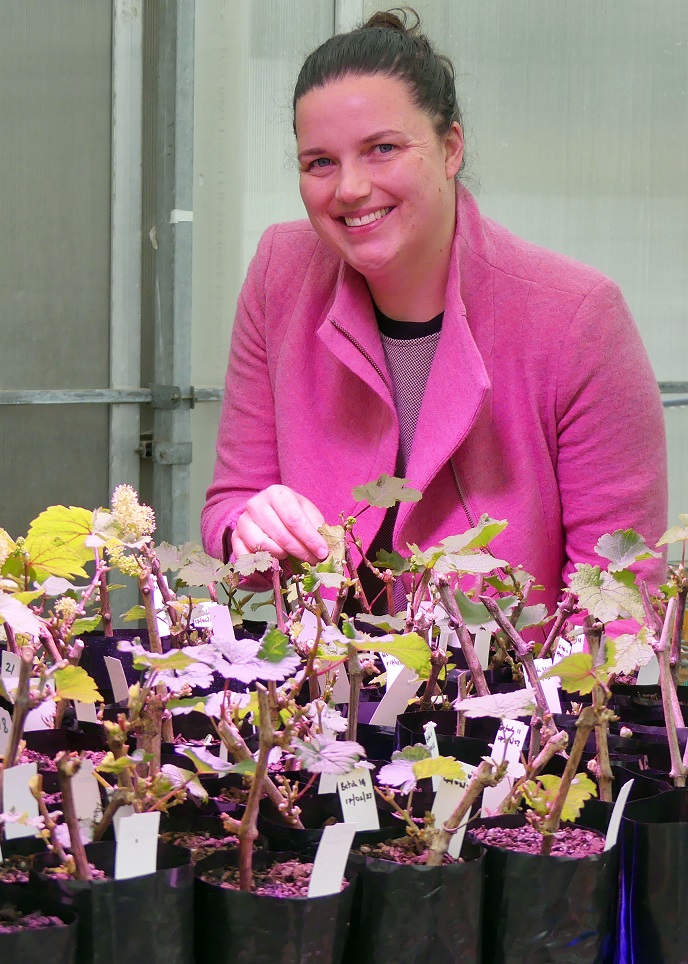
Trials are under way in Australia to see if spraying a biodegradable spray solution of clay particles will supress botrytis bunch rot disease in wine grapes.
It could be a game-changer for the wine industry, offering growers an innovative alternative to chemical fungicides. Working on the project at the Tasmanian Institute of Agriculture are Prof Kathy Evans, Dr Tory Clarke (above), and PhD student Akeem Taiwo. The project, which involves a new product called BioClay, is part of the Australian Research Council (ARC) Research Hub for Sustainable Crop Protection.
“This is the first time in the world that the BioClay technology is being tested for suppression of botrytis in wine grapes. The goal of our project is to investigate how the technology can work in this crop, and this will support the long-term development of a potential product for use here in Tasmania and around the world,” Dr Clarke said.
It is estimated that the processed value of wine grapes in Tasmania could be 24% higher if costs due to botrytis disease are recuperated.
BioClay is a completely new crop protection approach that was developed from research led by Prof Neena Mitter and Prof Gordon Xu at the University of Queensland. It is a biodegradable spray solution of clay particles that binds double-stranded (ds) RNA and releases it slowly, working with the plant’s naturally occurring mechanisms to stimulate the immune system to fight disease.
“At the moment we are working without the clay component to confirm that the RNA science works in grapevines. We are treating grape berries with the dsRNA product and then inoculating the berries with the botrytis fungus to establish how much we can reduce the incidence of disease with this treatment,” Dr Clarke said.
Dr Clarke said botrytis bunch rot is a major challenge for grapegrowers as it results in significant loss of yield and can create costly problems during winemaking, despite management practices being applied during the season.
“Botrytis can be triggered by weather events like rainfall in the weeks leading to harvest. Mould can appear really quickly, and you can go from having perfect grapes to losing your crop in a matter of days,” Dr Clarke said.
While the disease is seen in ripening fruit, infection may have occurred in grape flowers or unripe fruit. With this in mind, an important part of the project includes setting-up a novel system to give the research team access to flowering grapevines all year round.
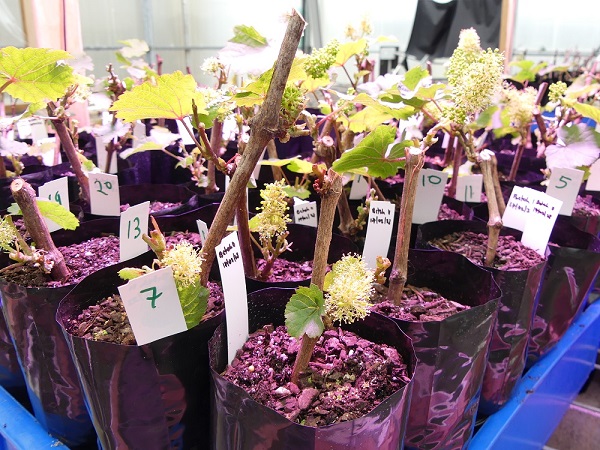
“One of the challenges we have in wine grapes is that it is a woody perennial plant which flowers just once a year. We know that flowering is a critical point in the disease development and so what we’ve done over the last year is set up a system where we can have access to flowering grapevines all the time,” Dr Clarke said.
“We propagate commercial cuttings of vines, get their roots growing and then put them in the glasshouse where we control temperature and light to replicate flowering conditions. Our little grapevines think it’s spring and so they start flowering. It takes around four months from cuttings to having vines with berries, but we now have regular batches of plants coming through our propagation system which flower and produce grape berries.”
After all the hard work setting up a mini vineyard, the research team now needs to inoculate the Riesling plants with botrytis so they can further test and develop the BioClay product, which is an invention by scientists from the University of Queensland that is being developed in partnership with Nufarm Limited.
“We will inoculate plants by puffing spores onto the flowers or fruit to replicate what would happen in the environment where spores would be in the air,” Dr Clarke said.
“We will test the BioClay effectiveness against botrytis bunch rot disease in glasshouse trials to develop an understanding of how to best use the product, including application, concentration, timing, and its effectiveness compared to other controls and chemical treatments currently used in vineyards.
“It will be interesting to see the results because coupling dsRNA to a clay stabilises it and results in a sustained release, so we can get longer protection for the crop compared to current chemical solutions that might be washed away by rain.”
dsRNA is a well understood, highly specific and targeted way to help plants protect themselves. It works with the plant’s natural mechanisms, stimulating the immune system to fight disease.
The clay particles on the leaf surface degrade in the presence of natural carbon dioxide and moisture, leaving no residue or toxins.
The research is in its early stages. The next phase will involve testing the BioClay product with the goal of developing an understanding of how best to apply it, including application method, concentration, and timing. The research team will also assess the product’s effectiveness compared to current commercial controls.
Prof Evans said producers are desperate for more options to control botrytis in vineyards.
“Good viticultural practices can counter some of the bad weather; however, a well-timed crop protectant can make the difference between a winemaker accepting or rejecting crop for a particular wine style. The big hope is that BioClay will prove to be a valuable addition to the toolbox,” Prof Evans said.
The project is part of the ARC Research Hub for Sustainable Crop Protection and funded by the Australian Government. The Australian Wine Research Institute and the South Australian Research and Development Institute are also contributing to the wine-grape research led from Tasmania.
These findings have the potential to revolutionise the agricultural industry
Building in disease resistance
The problem: Xylella fastidiosa, a grapevine diseaseThe breakthrough: The discovery of candidate genes for disease resistance in wild grape plants
A team of scientists in California has made a significant breakthrough in the battle against Xylella fastidiosa, a bacterium responsible for infecting various crops, including grapevines, coffee, almonds, citrus and olives.
A paper, published in Communications Biology, reveals the discovery of candidate genes for disease resistance in wild grape plants, offering hope for a future that is likely to be warmer.
Xylella fastidiosa has posed a significant challenge for farmers worldwide, with no known resistant varieties in major crops. However, building on a long-term project at UC Davis, the research team focused their attention on a wild grape species, Vitis arizonica, which exhibits natural resistance to the bacterium.
Through genetic mapping and genome-wide association studies, the researchers identified potential genes that could be introduced into grapevines to enhance their resistance. These findings have the potential to revolutionise the agricultural industry, offering a solution to the multibillion-dollar problem caused by Xylella fastidiosa.
One intriguing aspect of the study is the correlation between resistance genes and climate. The researchers discovered that the resistant genes were predominantly found in warm climates, indicating that the pathogen’s presence is more prevalent in these regions. By projecting climate change scenarios, the team predicts the future impact of the disease on various crops, including grapes and almonds.
“This study highlights the importance of scientific research in addressing the challenges posed by climate change and plant pathogens,” said Prof Brandon Gaut, who led the research at UC Irvine. “Understanding the genetic basis of resistance and the influence of climate on disease prevalence is crucial for developing effective strategies to protect our crops and ensure food security.”
The implications of this research extend beyond grapevines and offer insights into the genetic mechanisms of resistance in other susceptible crops, suggest the researchers. By harnessing the power of genetics, genomics, and studying wild plant relatives, scientists can identify valuable resistance traits that could enhance crop resilience against Xylella fastidiosa and similar pathogens.
“Preserving, maintaining and genetically characterising plant collections is paramount in our pursuit of discovering valuable genes for grape breeding programs,” commented Dario Cantù, who led the research at UC Davis.
Sanitising barrels
The problem: Eliminating bacteria, yeasts or fungal growth in barrels since the burning of sulphur wicks was limited by a European Union directiveThe solution: A combination of pressurised hot water treatment with UV-C radiation treatment as a disinfection complement
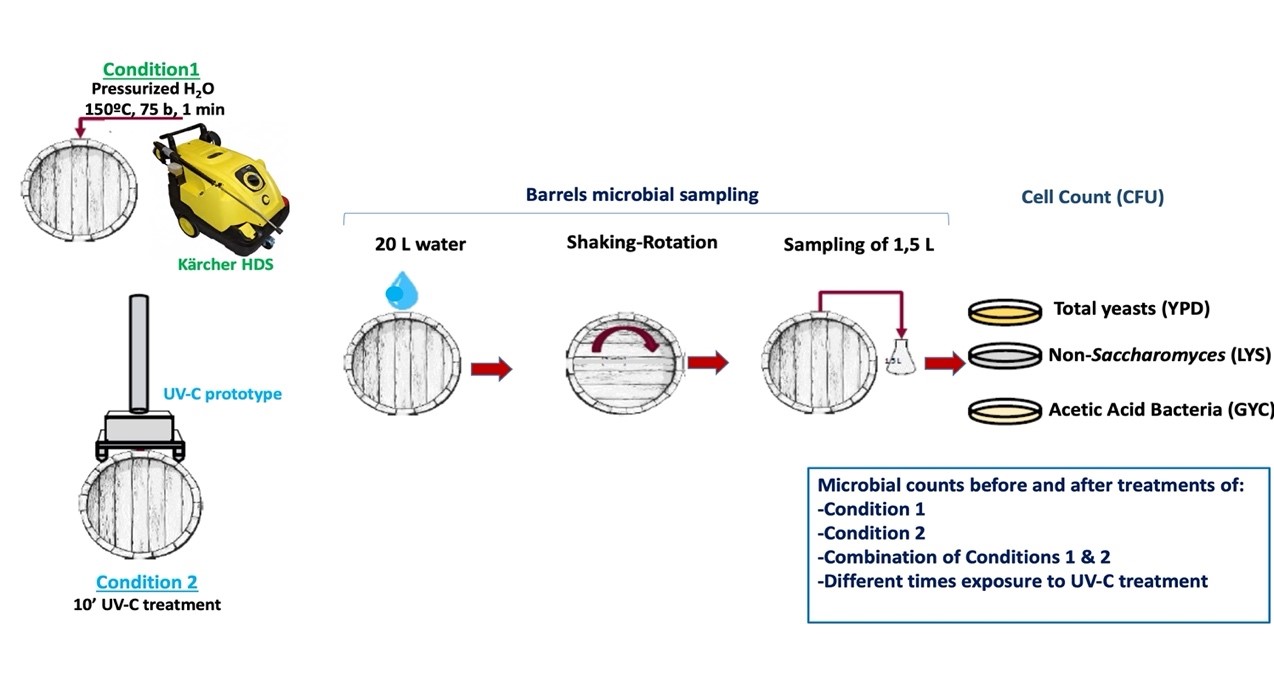
A new study from Spain has evaluated the germicidal potential of UV-C radiation applied to the interior of barrels. It found that using UV-C radiation to disinfect barrels for a maximum of 10 minutes after a 1-minute treatment with pressurised hot water was an effective solution in the battle against spoilage microorganisms, such as yeasts of the Brettanomyces genus and acetic acid bacteria.
What's more, the study said this combined treatment allows an effective level of disinfection to be obtained within a short period of time, providing benefits such as a reduction in energy and water consumption.
Chart below shows the effect of treatment on the reduction of total yeast populations. Treatment 1: Pressurised hot water, 1 min. Treatment 2: UV-C 10 min.
*: p < 0.05. ***: p < 0.0001
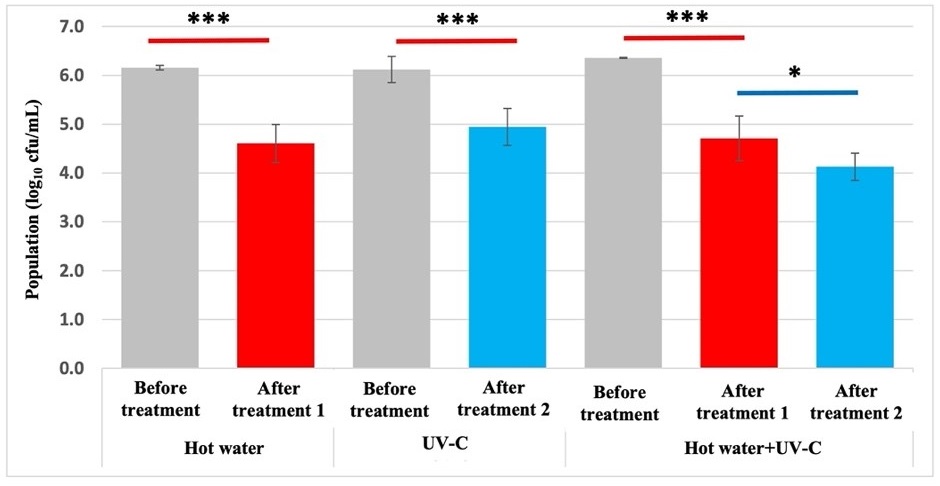
Chart below shows the effect of the treatment on the reduction of the populations of acetic acid bacteria. Treatment 1: pressurised hot water for 1 min. Treatment 2: UV-C for 10 min. NS: Not significant. ***: p < 0.001.
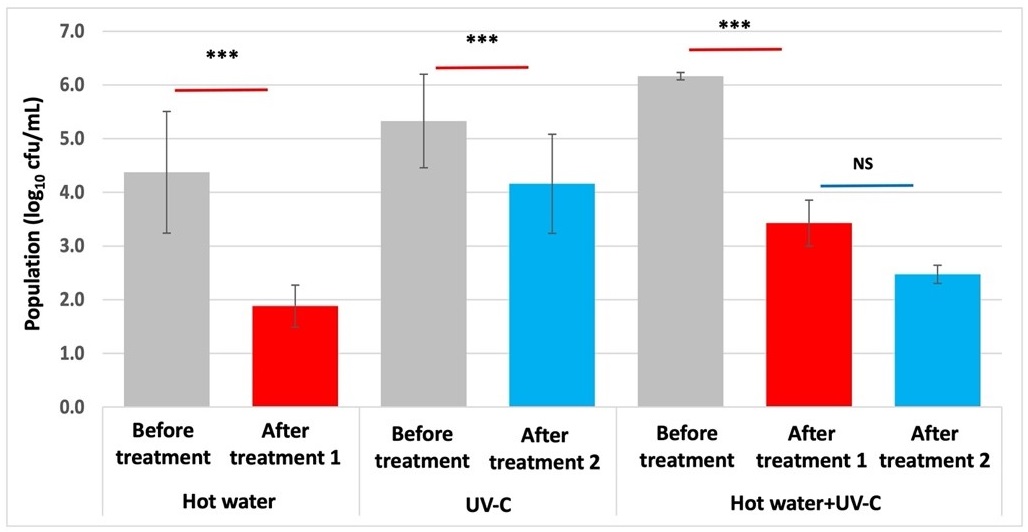
Graph below shows the effects of treatment duration on the reduction of populations of yeasts and acetic bacteria. Pressurised hot water treatment, 1 min and UV-C, 2.5, 5 and 10 min. Yeasts: no significant effect of treatment duration (p = 0.075). Acetic bacteria: there is a significant effect of treatment duration (p = 0.006).
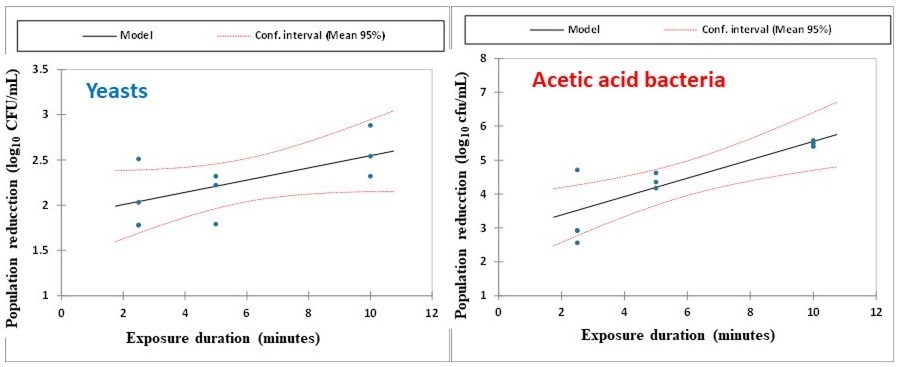







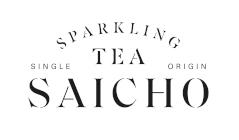





.png)






